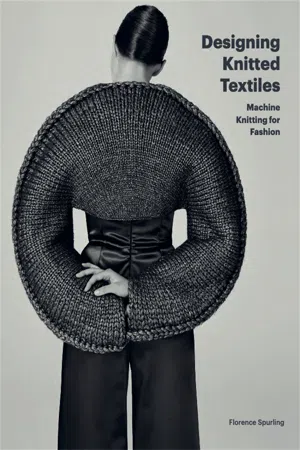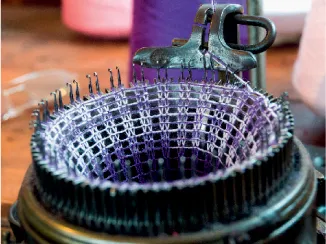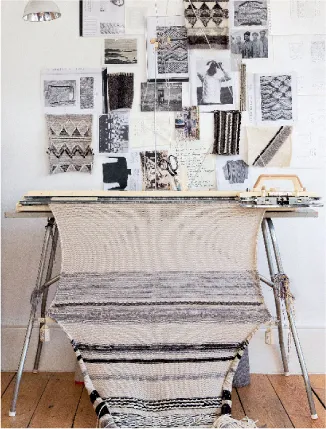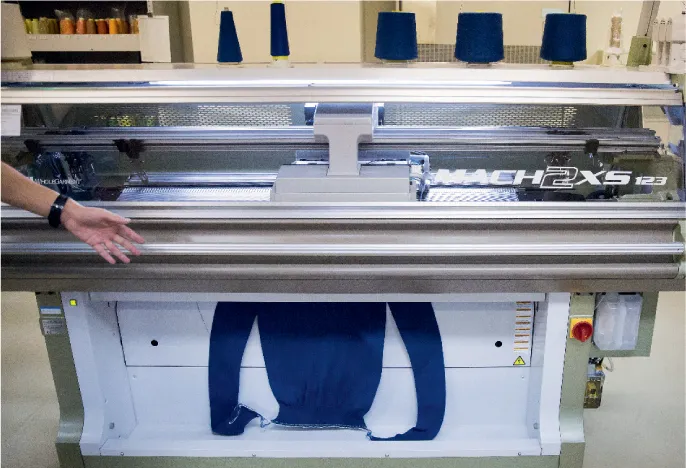
- 200 pages
- English
- ePUB (mobile friendly)
- Available on iOS & Android
About this book
Designing Knitted Textiles guides readers through the fundamental skills of machine knitting, while encouraging them to be creative and experimental. It takes a contemporary approach, exploring the countless possibilities of machine-knitted textiles within multiple fashion contexts.Part 1 offers a practical introduction to the subject, with step-by-steps and detailed information on tools, stitch types, fibres and techniques. Part 2 covers colour, pattern, texture, structure and embellishment, highlighting a range of designs from traditional styles such as Fair Isle to the most intricate lace or unusual 3D effects. Finally, Part 3 delves into the construction elements needed to create garments and accessories.Praise for Designing Knitted Textiles from academic reviewers: 'Perfect for beginners' knitwear course, to get a rounded understanding of the machine and capabilities'. - GEMMA MARSH, SAVANNAH COLLEGE OF ART AND DESIGN'It covers a wide range of single bed machine knitting techniques and includes inspirational images of knitted samples and garments. The book features technical information explaining how to knit many of the stitches, with clear diagrams and useful tips and hints. I will be recommending this book to all levels, as it has something to offer even the more experienced final year student'. DR VIKKI HAFFENDEN - UNIVERSITY OF BRIGHTON'This is a very clear a concise approach to machine knitting and design'. JOSEPH PESCATORE - NASSAU COMMUNITY COLLEGE'The book is beautifully written with a lot of excellent illustrations. The pictures of knitted designs are inspiring and relevant to contemporary fashion. An overall excellent book'. NICOLAS CHAMPROUX - HOUSTON COMMUNITY COLLEGE'This book has great illustrations and clear, easy-to-read text. There is a wide breadth of knowledge and a variety of techniques represented, and the tips are succinct and helpful. Equally appreciated are the many sources of knitwear inspiration'.
MEGHAN KELLY - THOMAS JEFFERSON UNIVERSITY
Frequently asked questions
- Essential is ideal for learners and professionals who enjoy exploring a wide range of subjects. Access the Essential Library with 800,000+ trusted titles and best-sellers across business, personal growth, and the humanities. Includes unlimited reading time and Standard Read Aloud voice.
- Complete: Perfect for advanced learners and researchers needing full, unrestricted access. Unlock 1.4M+ books across hundreds of subjects, including academic and specialized titles. The Complete Plan also includes advanced features like Premium Read Aloud and Research Assistant.
Please note we cannot support devices running on iOS 13 and Android 7 or earlier. Learn more about using the app.
Information

Part 1
Preparation
Chapter 1
The Knitting Machine
Types of Knitting Machine





Single-bed machine types
Knitting machine gauge
Purchasing a machine

How the Machine Works
The mechanics of the machine
Table of contents
- Cover
- Title
- Copyright
- Contents
- Introduction
- Part 1: Preparation
- Part 2: Materiality
- Part 3: Construction
- Troubleshooting and Videos
- Glossary
- Index
- Credits
- Acknowledgements